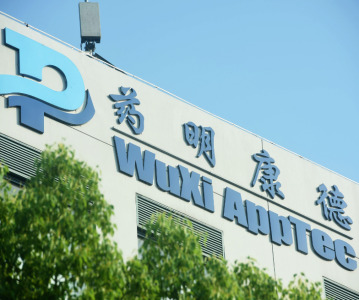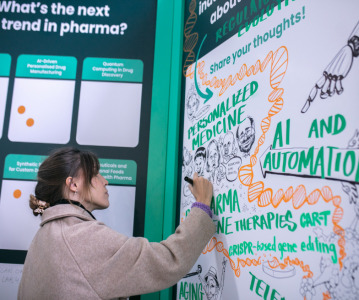Ingredients to improve bioprocess manufacturing efficiency

Experts warn bio industry needs to do more to create a sustainable pipeline of talent.
A report from bioLIVE – the new UBM biomanufacturing and bioprocessing event taking place in Madrid (9-11 October 2018) – has collected findings from a panel of experts to identify a number of potential applications of small molecule expertise that should be applied to the biologics industry. The report forecasts the increasing role outsourcing will play in the bio supply chain and how continuous processing, API and process analytical technology (PAT) expertise will be integral to future growth.
Establishing a sustainable pipeline of qualified staff into the rapidly maturing biologics supply chain has been identified as a key issue. Data from the 2018 BioPlan Associates Annual Survey identified three key areas where small molecule expertise could see cross-industry benefits – ‘process control’ (33%), ‘quality management’ (30%), and ‘training operators and technicians’ (29%).
Emil Ciurczak of Doramaxx Consulting, a CPHI Annual Report expert, argues this is only the tip of the iceberg, and that if the question was to be reversed, i.e., asking small molecule experts about the areas where their technology could be of use to the large molecule industry, the positive responses would be much higher. "Although the positive response data from biopharmaceutical manufacturers may not appear that high, this could be due to a lack of familiarity with the level of expertise of technology available to them, rather than a firm understanding of the sector and a discounting of its relevance." For instance, Raman and NIRS (near-infrared spectroscopy) could be used for testing incoming raw materials, checking clinical supplies, and – comparing fermentation to API synthesis – monitoring a reaction (even if final release is by compendial methods).
He also identified the implementation of PAT as a key area for greater collaboration: "... indeed, the FDA plainly stated that the Guidances and ICH Q8, 9, and 10 were designed for small molecules. Consequently, a 'pure' biologics company will lack direct experience with PAT and there is a time gap in familiarity." But he warned that ‘the bio industry needs to do more to attract talent, as seldom do small molecule personnel switch careers to work in biopharma companies’.
With the industry still debating on how best to bring CAR-T therapies, amongst others, into commercial production, Girish Malhotra argued that the small molecule industry’s 50+ years of manufacturing pedigree can bring vital contributions. Examining the emergence of continuous bioprocessing, Malhotra said: "(bio) manufacturers will need experienced fermentation masters, chemists and chemical engineers who understand finances, process development and process simplification values."
Another surprising area for cross-industry collaboration is between API experts and bio, as the instruments used for chemical and physical measurements for API production may only need minor alterations to be useful in fermentations. "Continuous chromatography, which is beginning to become more common in API work, could also be used in bioprocesses," concluded Ciurczak.
The report predicts that over the next few years, th industry is likely to see a ‘technological arms race’ amongst outsourcing providers to help increase efficiencies, lower costs and decrease clinical timelines in bio development and manufacturing. To take just one example, technologies that help reduce the cost of the expensive protein A capture step in biomanufacturing could potentially represent a huge process improvement.
Regarding contract manufacturing, the report predicts cell and gene CDMOs growing quickly, all be it from a low base – especially as more products enter commercial stage. Another approach to differentiate and achieve growth for smaller bio CDMOs is novel technologies that speed production and lower costs. Already we have seen big pharma partnering with a number of smaller biotechs for anything from AI technologies to 3D micro-organoid modelling and bioprocess improvements – the latter is where there will likely be a new ‘arms race’ for the best technologies amongst outsourcing providers. Big Pharma will also seek to mirror its approach in the small molecule industry, and mitigate supply chain risk, by seeking to partner with several CDMOs in both development and commercialisation of its most profitable new targets.
Rutger Oudejans, Brand Director Pharma at UBM (part of Informa PLC), commenting on bioLIVE’s first industry whitepaper, added: “We are only just now beginning to see the potential of a cross-industry collaboration between these two formerly distinct industries. And our experts are only just starting to explore the ways in which these two industries could collaborate to improve production timelines, efficiencies and regulatory compliance. Already there is a consensus that API technology could be applicable and that bio companies should encourage more small molecule experts into the industry as it grows. Particularly, those with PAT and process development expertise. That is without even considering how the two pipelines are becoming increasingly blurred with peptides and ADCs. A key part of our value proposition with bioLIVE is to open the debate and increasingly foster collaborations between the two. With our co-located events, CPHI and ICSE – API & contract services respectively – the complete supply chain will be able to meet new partners. This will prove essential to a quickly maturing bio supply chain, and will be key to future development.”
Related News
-
News WuXi to sell CGT manufacturing unit to US-based Altaris LLC
At the tail end of 2024, Chinese-based CDMO WuXi AppTec announced the signing of their deal with private equity firm Altaris LLC, confirming the sale of WuXi Advanced Therapies, the cell and gene therapy manufacturing arm of WuXi AppTec. -
News Women in Pharma: Our hopes for 2025 and beyond
Our last instalment for 2024 of the Women in Pharma series brings you messages direct from the Informa Markets CPHI team as they discuss the advice and insights they have carried throughout their roles working at CPHI, and what they hope to see for the... -
News CPHI Milan Wrap-Up Report: Conference Highlights
Discover the emerging and trending topics of the pharmaceutical industry with our CPHI Milan Conference Highlights, with exclusive insight from pharmaceutical leaders and experts! -
News BIOSECURE Act not included in key defense spending bill for 2025
On December 7, 2024, the Biden administration revealed the 2025 National Defense Authorization Act, an annual defense bill specifying the budget and expenditures of the US Department of Defense. The controversial BIOSECURE Act was notably missing from ... -
News Lessons from CPHI Milan 2024: Sunny Intervals for Pharma Manufacturing?
As the 2024 CPHI conference wrapped up in Milan, we caught up with L.E.K. Consulting – a global strategy consulting firm with deep expertise in pharma manufacturing – to discuss evolving market perspectives and business outlook. -
News Trump 2.0: What does the US election result mean for the healthcare industry?
After Trump won the Presidential election in the US in early November, we take a look at some of the implications a new Trump administration could have on the health and pharmaceutical industry, and on US patients. -
News Women in Pharma: Reflections from Behind the Scenes
In this instalment of our monthly series, the team that brings you the Women in Pharma series each month sits down for a heart-to-heart on what the series means to them, and how they hope to continue their work in the future. -
News Scaling the Industry: CPHI Scale-Up Market interview with YSK Laboratories
For the first time, CPHI Milan hosted the CPHI Start-Up Market, expanding support for emerging and small-sized enterprises in their transition to the next level of growth. In this interview, we spoke with Yuvansh Khokhani, Managing Director of YSK Labo...
Recently Visited
Position your company at the heart of the global Pharma industry with a CPHI Online membership
-
Your products and solutions visible to thousands of visitors within the largest Pharma marketplace
-
Generate high-quality, engaged leads for your business, all year round
-
Promote your business as the industry’s thought-leader by hosting your reports, brochures and videos within your profile
-
Your company’s profile boosted at all participating CPHI events
-
An easy-to-use platform with a detailed dashboard showing your leads and performance

.png)





